Elevate Your Home with Proper Curtain Cleaning Methods
Posted on 08/06/2025
Elevate Your Home with Proper Curtain Cleaning Methods
Are you looking for simple ways to freshen your living space? Start with your curtains! Discover how proper curtain cleaning methods can elevate your home's ambiance, ensure a healthier environment, and preserve the beauty of your window treatments for years to come.

Why Curtain Cleaning Is Essential for a Beautiful Home
Many homeowners overlook the importance of curtain care. Yet, clean curtains not only enhance the aesthetics of a room but also contribute to a cleaner and healthier home environment. Throughout the day, curtains accumulate dust, allergens, odors, and even mold spores, which can compromise both the look of your space and the air quality within it.
Let's explore why proper curtain cleaning is a non-negotiable aspect of home maintenance:
- Improved Air Quality: Curtains can trap pollutants and allergens, especially in urban areas or homes with pets.
- Prolonged Fabric Life: Regular cleaning prevents dirt and debris from breaking down delicate fabrics.
- Allergy Relief: Clean window treatments can help reduce sneezing, watery eyes, and other allergy symptoms.
- Enhanced Appearance: Sparkling clean curtains elevate your home's overall appearance, creating a fresher, more inviting space.
- Odor Elimination: Odors from cooking, pets, or outdoor pollution can cling to fabric. Regular cleaning helps keep your home smelling fresh.
How Often Should You Clean Curtains?
The frequency of curtain cleaning depends on several factors, including fabric type, household environment, and your personal preferences. Here are some general guidelines:
- Lightweight or sheer curtains: Every 3-6 months.
- Heavy drapes or blackout curtains: Once every 6-12 months.
- Homes with smokers, pets, or allergy sufferers: More frequent cleaning is advisable--every 3-6 months, regardless of fabric type.
Top Curtain Cleaning Methods to Try Today
Different fabrics and curtain styles require unique cleaning approaches. Here's a comprehensive guide to effective solutions for keeping your curtains spotless without causing damage:
1. Vacuuming Curtains
Vacuum cleaning is a quick and low-effort way to remove dust and allergens.
- How to: Use your vacuum's upholstery or brush attachment. Gently work from top to bottom, paying extra attention to hems and folds where dust can gather.
- Pro Tip: Close the curtains fully so the fabric hangs straight for even cleaning.
2. Spot Cleaning Curtains
Spills and stains are inevitable, but prompt action can prevent permanent damage.
- How to: Blot the stain gently with a clean, damp cloth and a mild detergent solution. Always test on an inconspicuous area first.
- Avoid rubbing as this may push stains deeper into the fibers.
3. Machine Washing Window Treatments
Many modern curtains are machine washable. Here's how to do it right:
- Check the label: Always confirm washing instructions--certain fabrics like silk or velvet are not machine-safe.
- Use cold water and mild detergent to protect colors and fibers.
- Wash separately from other laundry.
- Dry naturally: Hang immediately after washing to prevent wrinkles.
4. Hand Washing Delicate Curtains
For delicate or vintage window coverings, gentle hand washing is best.
- Fill a tub with cold water and add a mild detergent suitable for delicate fabrics.
- Soak curtains for 10-15 minutes and move gently through the water. Avoid wringing or twisting.
- Rinse thoroughly and hang to dry away from direct sunlight.
5. Steam Cleaning Curtains
Steam cleaning is ideal for refreshing heavy or hard-to-remove curtains right where they hang.
- Use a handheld steamer and run it over the fabric slowly, keeping a safe distance to avoid watermarks.
- Let curtains air dry completely after steaming.
- Bonus: Steam helps to remove wrinkles and kill bacteria.
6. Professional Curtain Cleaning Services
If your drapes are made from luxury fabrics or have complex designs, trust the experts.
- Professional cleaners have specialized equipment for cleaning, sanitizing, and restoring curtains with zero risk of damage.
- This is essential for curtains exposed to heavy smoke, mold, or stubborn stains.
7. Dry Cleaning Curtains
Some materials, such as silk, velvet, or lined drapes, require dry cleaning to maintain their shape and appearance.
- Look for "Dry Clean Only" on care labels.
- Take your curtains to a reputable dry cleaner experienced in handling window furnishings.
Maintaining Curtain Freshness Between Cleanings
Consistent care is key to extending curtain life and keeping your home looking its best. Follow these quick tips to minimize the buildup of dust and odors:
- Shake curtains gently outdoors every few weeks to dislodge loose dust and debris.
- Open windows regularly to increase airflow and prevent moisture-related issues like mold growth.
- Use a fabric freshener spray (test on a hidden area first) to instantly refresh fabrics.
- Rotate curtains around your home to distribute sun exposure and wear evenly.
Choosing the Right Cleaning Products for Your Curtains
Not all detergents and cleaning agents are created equal. To avoid damaging your drapes, consider the following tips when selecting products:
- Avoid harsh chemicals: Bleach or ammonia-based products can fade and weaken fabric fibers.
- Opt for fragrance-free or hypoallergenic detergents, especially if you or your family members suffer from allergies.
- Test cleaning solutions on an inconspicuous section of your curtain first to ensure compatibility.
- Choose wool or silk-specific products for fine curtains--they clean gently and effectively without residue.
Understanding Curtain Fabrics and Their Cleaning Needs
Curtain fabrics vary widely, and so do their cleaning requirements. Here's a quick overview of common window treatment materials and recommended curtain cleaning techniques:
- Cotton: Machine washable, dries quickly, but may shrink if not handled properly. Use cold water cycles and air dry.
- Polyester: Durable and easy to wash. Machine-safe but should be washed with mild detergents on gentle settings.
- Velvet: Must be dry cleaned or gently steamed. Avoid exposing to direct sunlight or high humidity.
- Silk: Professional or dry cleaning recommended--silk is highly sensitive to water and detergents.
- Linen: Can be hand washed or machine washed on a delicate cycle. Avoid hot water and tumble drying.
Common Curtain Cleaning Mistakes to Avoid
Even the most detail-oriented homeowners can make errors when cleaning curtains. Here are the most frequent pitfalls and how to sidestep them:
- Ignoring care labels: Always read and follow cleaning instructions to avoid shrinkage, color loss, or fabric damage.
- Excessive water use: Over-saturating delicate curtains can cause warping and stains. Use minimal water for delicate materials.
- Using hot water: This can cause certain fabrics (like cotton and linen) to shrink or lose shape.
- Skipping spot tests: Always verify how your cleaning solution interacts with curtain fabrics before full application.
- Neglecting to remove hardware: Take down hooks, rings, and other attachments before washing to avoid rust or snags.
Expert Tips for Curtain Cleaning Success
- Regular Cleaning: Set a reminder to clean curtains alongside other routine household chores.
- Use Gentle Motions: Whether vacuuming, hand washing, or steaming, be gentle to avoid damaging fibers and seams.
- Prompt Spot Treatments: Address stains as soon as they appear to prevent them from setting.
- Rotate Curtains: Switching curtains between rooms can balance light exposure and wear, helping fabrics last longer.
- Check for Damage: Inspect for loose threads, sun damage, or hardware issues before cleaning and make any needed repairs first.
DIY Curtain Deodorizer Recipe
Sometimes store-bought sprays simply don't cut it. Try this simple DIY deodorizer to revitalize window treatments between cleanings:
- Mix 1 cup of water, 2 tablespoons of baking soda, and a few drops of your favorite essential oil in a spray bottle.
- Lightly mist curtains--never saturate! Make sure to test a patch first.
- Allow to air dry. Repeat as needed to keep your home smelling delightful.

Frequently Asked Questions about Curtain Cleaning
Can you clean curtains without removing them?
Yes! Vacuuming and steam cleaning are excellent methods to refresh curtains while they are still hanging.
How can you prevent curtains from fading?
Use UV-blocking window film or rotate curtains to minimize sun exposure. Avoid harsh chemicals or high-heat drying methods.
Are blackout curtains harder to clean?
Blackout curtains often have a thick, coated lining that can be sensitive to water and heat. Always follow manufacturer instructions and consider professional cleaning for best results.
Do all curtains need dry cleaning?
Only certain materials (such as silk, velvet, or interlined drapes) require dry cleaning. Always check the care label before attempting other methods.
Conclusion: Refresh Your Space by Cleaning Curtains the Right Way
To elevate your home and create a clean, vibrant atmosphere, don't neglect your curtains. By embracing proper curtain cleaning methods--from regular vacuuming to professional services--you can extend the life of your window dressings, boost indoor air quality, and keep your decor looking stunning all year round.
Remember, invest in routine curtain cleaning and your home will return the favor with freshness, beauty, and a welcoming ambiance. Ready to get started? Try one of these cleaning methods today and experience the difference for yourself!



